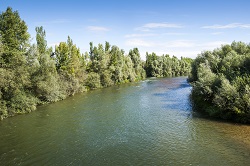Accurately assessing global river-floodplain forest strategies
Riparian (river-floodplain) forests, which are unique sources of biodiversity, food and raw materials, are under increasing threat from urban, industrial and agricultural development. In order to ensure their survival, a number of restoration projects have been launched across the globe over the past few decades in an attempt to ensure compatibility between self-sustainable and healthy river-floodplain forests with human activity. ‘Many restoration projects have sought to deal with a variety of environmental problems that affect riparian forests,’ explains ESFFORES project coordinator Dr Eduardo González, who carried out the project at the University of Denver in the US and the Laboratoire d'Écologie Fonctionnelle et Environnement in Toulouse, France. ‘The sheer variety of these approaches, together with a lack of funding for proper monitoring, means that no systematic objective or standard criteria to evaluate their success or failure has ever been put in place. This ultimately jeopardises their impact.’ Measuring success In order to address this, the ESFFORES project sought to assess the effectiveness of various restoration projects in order to open up discussion on establishing universal criteria for declaring success. Data on environmental management and vegetation variables was recorded at a variety of sites across two semi-arid regions of the western US and southern Europe, with climatic gradients covering different reaches of six large river basins: Middle Rio Grande, Upper and Lower Colorado, Ebro, Duero and Garonne. ‘By concentrating our efforts on evaluating results – rather than in defining goals and implementation techniques – we were able to combine traditional evaluations using local and site-specific data with larger spatial evaluations over longer periods of time,’ says González. ‘The inclusion of very different restoration strategies from around the world, at large spatial and long temporal scales, allowed us to identify some universal indicators responsive to restoration and universal factors leading to success or failure.’ The project found that similar plant diversity metrics can be used to evaluate the success of very different restoration approaches, but that some metrics are more responsive to restoration than others. Furthermore, restoration outcomes in floodplain forest restoration resulting from different strategies can be partially predicted by readily measurable environmental parameters, such as climate. ‘Restoration approaches alone cannot restore pre-disturbance conditions, but can greatly influence vegetation successional trajectories,’ says González. ‘This is important as it gives us room for manoeuvre to modify the ecosystem to satisfy our needs in a sustainable way. An unexpected result was that successful restoration was not necessarily more likely with active revegetation, if natural processes such as flooding are restored.’ A global perspective The project was made possible by a Marie Curie International Outgoing Fellowship (IOF) grant, which involved González spending two years in a non-European country and one year in Europe. Leading scientists in the field of riparian restoration ecology supervised the project in Europe and the US. ‘This framework really suited me as a fundamental aspect of my project was to compare different restoration approaches between world regions,’ explains González. ‘I was able to meet with some of the most reputed riparian ecologists in North America and learn about their approaches to manage invasions of exotic plants, which is the main motivation of floodplain forest restoration projects in the southwestern US.’
Countries
France



